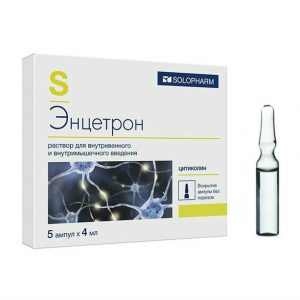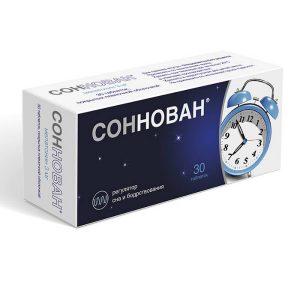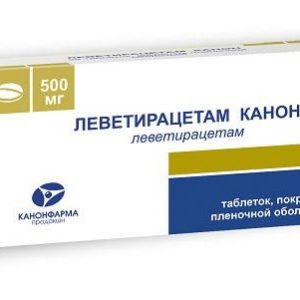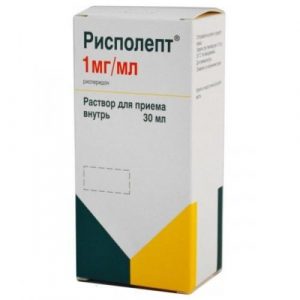Description
release form
tablets
Packing
30 tablets.
Pharmacological action of
Solian is an antipsychotic drug (antipsychotic)
Pharmacodynamics
Amisulpride binds selectively with high affinity to D2 / D3 subtypes of dopaminergic receptors, while it does not have D1 subtype affinity for D4.
Unlike classical and atypical antipsychotics, amisulpride has no affinity for serotonin, histamine H1, alpha-adrenergic and cholinergic receptors. In addition, amisulpride does not bind to sigma sites. When used in high doses, it blocks postsynaptic D2 receptors localized in limbic structures, in contrast to similar striatum receptors. It does not cause catalepsy and does not lead to the development of hypersensitivity to D2-dopamine receptors after repeated treatment.
In low doses, it predominantly blocks presynaptic D2 / D3 receptors, causing the release of dopamine, which is responsible for its disinhibitory effects. Such an atypical pharmacological profile may explain the antipsychotic effect of amisulpride at high doses resulting from blockade of postsynaptic dopamine receptors and its effectiveness against negative symptoms at low doses as a result of blockade of presynaptic dopamine receptors.
In addition, amisulpride is less likely to cause extrapyramidal side effects, which may be due to its predominant limbic activity.
In patients with acute schizophrenia, Solian acts both on secondary negative symptoms and on affective symptoms, such as depressed mood and retardation.
Pharmacokinetics of
Amisulpride has two absorption peaks: one is reached quickly, one hour after the dose, and the second between 3 and 4 hours after administration. The plasma concentration, respectively, is 39 ± 3 and 54 ± 4 ng / ml, after taking 50 mg.
Distribution volume is 5.8 l / kg. Since plasma protein binding is low (16%), interaction with other drugs is unlikely.
Absolute bioavailability is 48%. Amisulpride metabolizes poorly: (about 4%, two inactive metabolites have been identified. Amisulpride does not accumulate and its pharmacokinetics remain unchanged after repeated doses.
The half-life (T1 / 2) of amisulpride is approximately 12 hours after taking an oral dose.
Amisulpride with urine unchanged. Renal clearance is approximately 20 l / h or 330 ml / min.
A carbohydrate-rich food (containing 68% liquid) significantly reduces AUC (the area under the concentration / time curve), the time to reach the maximum concentration and the maximum concentration of amisulpride itself, but there have been no changes in the pharmacokinetics after eating fatty foods. However, the significance of these observations in everyday clinical practice is unknown.
Hepatic failure. Due to the fact that the drug is poorly metabolized, there is no need to reduce the dose for patients with impaired liver function.
Renal failure. T1 / 2 in patients with renal failure does not change, but systemic clearance decreases with a coefficient of 2.5 to 3. The AUC of amisulpride in case of small renal failure is doubled, and with moderate insufficiency, almost ten times (see section Dosage and administration). Practical experience, however, is limited, and there are no results on the use of doses in excess of 50 mg.
Amisulpride is poorly dialyzed.
A limited number of pharmacokinetic data for elderly (over 65 years) patients suggests that after a single oral administration of 50 mg of Cmax, T1 / 2 and AUC is 10-30% higher than in younger people. There are no data on the pharmacokinetics of the drug during long-term treatment.
Indications
Acute and chronic schizophrenia, accompanied by pronounced productive (including delusions, hallucinations, thinking disorders) and / or negative (including affective flatness, lack of emotionality and avoiding communication) disorders, including h in patients with a predominance of negative symptoms.
Contraindications
– Concomitant prolactin-dependent tumors (including pituitary prolactinoma, breast cancer).
– Pheochromocytoma.
– Severe renal failure (CC less than 10 ml / min).
– Combined use with suloprid.
– Combined use with dopaminergic agonists (including amantadine, apomorphine, bromocriptine, cabergoline, entacapone, lisuride, pergolide, pyribedil, pramipexole, quinagolide, ropinirole, selegiline), with the exception of patients with Parkins disease.
– Children under 14 years old.
– Lactation (breastfeeding).
– Hypersensitivity to amisulpride and other components of the drug.
Caution is advised to use the drug in: – Pregnancy.
– Epilepsy.
– Parkinsonism.
– Renal failure.
– In elderly patients.
Pregnancy and lactation
The safety of amisulpride during pregnancy has not been established. Consequently, the use of the drug during pregnancy is not recommended, unless the intended benefit to the mother justifies the potential risk to the fetus.
The use of amisulpride during lactation is contraindicated.
Composition
1 tablet contains : active substance: amisulpride 400 mg,
excipients: potato starch, lactose, monohydrate, methyl cellulose, colloidal aqueous silica, magnesium stearate
Dosage and administration of
In acute psychotic episodes, the recommended dose is 400 to 800 mg / day. In some cases, if necessary, the dose can be increased to 1200 mg / day. Doses are increased taking into account the individual tolerance of the drug. The maximum daily dose should not exceed 1200 mg.
In case of mixed negative and productive symptoms, the doses should be selected so as to provide optimal control over the productive symptoms: on average, from 400 mg to 800 mg / day Supportive treatment should be established individually at the minimum effective dose level.
Recommended daily dosage varies from 50 to 300 mg. Selection of doses should be individual.
Olian patients should be given special care with Solian because of the possible development of arterial hypotension or excessive sedation.
In doses exceeding 400 mg / day, Solian should be prescribed in 2 divided doses.
For ease of dosing, Solian tablets can be used. 400 mg 30 Sanofi-Aventis.
Side effects
Side effects are presented in accordance with the following gradations of their frequency of occurrence: very often (> 10%), often (> 1%, 0.1%, 0.01%,
The side effects observed in the controlled are listed below clinical studies and the post-marketing use of the drug.It should be noted that in some cases it is very difficult to differentiate side effects from the symptoms of the underlying disease
From the nervous system: very often – extrapyramidal symptoms (tremor, stiffness, gi pokinesia, hypersalivation, akathisia, dyskinesia). These symptoms are usually mild when taken in optimal doses and partially reversible when anticholinergic antiparkinsonian drugs are added without discontinuing treatment with amisulpride. The incidence of extrapyramidal symptoms is dose dependent. Therefore, in patients with predominantly negative symptoms, taking amisulpride at a dose of 50-300 mg, the incidence of extrapyramidal disorders is very low often – acute dystonia (spasmodic torticollis, oculogyric crises, trismus), reversible when anticholinergic antiparkinsonian drugs are added without stopping treatment with amisulpride daytime drowsiness infrequently – late dyskinesias, characterized by rhythmic, involuntary movements of mainly the tongue and / or muscles of the face, which usually occur after prolonged use of the drug. Anticholinergic antiparkinsonian drugs in these cases are ineffective or may increase the symptoms of seizures, an unknown frequency – malignant antipsychotic syndrome (see. “Special instructions”).
From the gastrointestinal tract: often – constipation, nausea, vomiting, dry mouth.
From the endocrine system: often – amisulpride causes an increase in plasma concentrations of prolactin, reversible after discontinuation of the drug. This can lead to galactorrhea, amenorrhea, gynecomastia, pain in the mammary glands and erectile dysfunction.
Metabolic disorders: often – increased body weight infrequently – hyperglycemia (see “Contraindications,” With caution “and” Special instructions “).
Disorders of the cardiovascular system: often – arterial hypotension infrequently – bradycardia unknown frequency – lengthening of the QT interval ventricular rhythm disturbances, such as polymorphic ventricular tachycardia of the pirouette type (torsade de pointes), which can go into ventricular fibrillation and lead to cardiac arrest and sudden death (see Special instructions ) thromboembolism, including pulmonary embolism, sometimes fatal and deep vein thrombosis (see Special instructions ).
On the part of laboratory parameters: infrequently – an increase in the levels of liver enzymes, mainly transaminases.
From the side of the immune system: infrequently – allergic reactions.
Others: often – insomnia, anxiety, agitation, orgasm disorders, frigidity.
overdose Symptoms: The experience with overdose of amisulpride is very limited. A significant increase in known pharmacological effects of the drug has been reported, namely, the development of drowsiness, sedation, coma, arterial hypotension and extrapyramidal symptoms.
It should be borne in mind that the effects of overdose can occur in cases of mistaken administration of additional doses of the drug or simultaneous administration of other drugs.
Treatment: There is no specific antidote for amisulpride.
In case of overdose, the basic vital functions of the body should be monitored and maintained until the patient completely leaves the overdose state. In case of overdose, ECG monitoring is mandatory, since there is a risk of prolonging the QT interval and the development of life-threatening rhythm disorders (see Side Effects ).
In case of severe extrapyramidal symptoms, anticholinergic agents should be used.
T.k. elimination of amisulpride by hemodialysis is insignificant, it is impractical to remove it with an overdose with hemodialysis.
Storage conditions
The drug should be stored in a dry place at a temperature below 25 ° C.
The Expiration of
is 3 years.
Deystvuyuschee substances
Amysulpryd
dosage form
dosage form
tablets
Sanofi-Aventis, France




